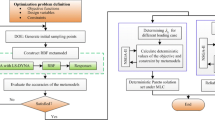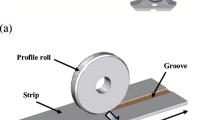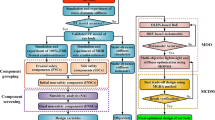Abstract
Crashworthiness of tailor-welded blank (TWB) structures signifies an increasing concern in lightweight design of vehicle. Although multiobjective optimization (MOO) has to a considerable extent been successfully applied to enhance crashworthiness of vehicular structures, majority of existing designs were restricted to single or uniform thin-walled components. Limited attention has been paid to such non-uniform components as TWB structures. In this paper, MOO of a multi-component TWB structure that involves both the B-pillar and inner door system subjected to a side impact, is proposed by considering the structural weight, intrusive displacements and velocity of the B-pillar component as objectives, and the thickness in different positions and the height of welding line of B-pillar as the design variables. The MOO problem is formulated by using a range of different metamodeling techniques, including response surface methodology (RSM), artificial neural network (ANN), radial basis functions (RBF), and Kriging (KRG), to approximate the sophisticated nonlinear responses. By comparison, it is found that the constructed metamodels based upon the radial basis function (RBF, especially multi-quadric model, namely RBF-MQ) fit to the design of experiment (DoE) checking points well and are employed to carry out the design optimization. The performance of the TWB B-pillar and indoor panel system can be improved by optimizing the thickness of the different parts and height of the welding line. This study demonstrated that the multi-component TWB structure can be optimized to further enhance the crashworthiness and reduce the weight, offering a new class of structural/material configuration for lightweight design.













Similar content being viewed by others
References
Ahmad Z, Thambiratnam DP (2009) Dynamic computer simulation and energy absorption of foam-filled conical tubes under axial impact loading. Comput Struct 87(3–4):186–197
Aslanlar S, Ogur A, Ozsarac U, Ilhan E, Demir Z (2007) Effect of welding current on mechanical properties of galvanized chromided steel sheets in electrical resistance spot welding. Mater Des 28(1):2–7
Baş D (2007a) Modeling and optimization I: usability of response surface methodology. J Food Eng 78(3):836–845
Baş D (2007b) Modeling and optimization II: comparison of estimation capabilities of response surface methodology with artificial neural networks in a biochemical reaction. J Food Eng 78(3):846–854
Bezerra MA, Santelli RE, Oliveira EP, Villar LS, Escaleira LA (2008) Response surface methodology (RSM) as a tool for optimization in analytical chemistry. Talanta 76(5):965–977
Booker AJ, Dennis JE, Frank PD, Serafini DB, Torczon V, Trosset MW (1999) A rigorous framework for optimization of expensive functions by surrogates. Struct Multidisc Optim 17(1):1–13
Chuang CH, Yang RJ, Li G, Mallela K, Pothuraju P (2008) Multidisciplinary design optimization on vehicle tailor rolled blank design. Struct Multidisc Optim 35(6):551–560
Chung KH, Lee W, Kim JH, Kim C, Park SH, Kwon D, Chung K (2009) Characterization of mechanical properties by indentation tests and FE analysis-validation by application to a weld zone of DP590 steel. Int J Solids Struct 46(2):344–363
Da Y, Ge XR (2005) An improved PSO-based ANN with simulated annealing technique. Neurocomputers 63:527–533
Davies R, Grant G, Smith M, Oliver E (2000) Formability and fatigue of aluminum tailor-welded blanks. SAE Transact: J Mater Manuf 109:911–918
Deb K, Agrawal S, Pratap A, Meyarivan T (2000) A fast elitist non-dominated sorting genetic algorithm for multiobjective optimization: NSGA-II. Lect Notes Comput Sci 1917:849–858
Deb K, Pratap A, Agarwal S, Meyarivan T (2002) A fast and elitist multiobjective genetic algorithm: NSGA-II. Evolutionary computation. IEEE Trans Evol Comput 6(2):182–197
Deb K, Rao NU, Karthik S (2007) Dynamic multiobjective optimization and decision-making using modified NSGA-II: a case study on hydro-thermal power scheduling. Springer, New York
Fang H, Rais-Rohani M, Liu Z, Horstemeyer MF (2005a) A comparative study of metamodeling methods for multiobjective crashworthiness optimization. Comput Struct 83(25):2121–2136
Fang H, Solanki K, Horstemeyer MF (2005b) Numerical simulations of multiple vehicle crashes and multidisciplinary crashworthiness optimization. Int J Crashworthiness 10(2):161–172
Florian A (1992) An efficient sampling scheme: updated latin hypercube sampling. Probab Eng Mech 7(2):123–130
Forrester AIJ, Keane AJ (2009) Recent advances in surrogate-based optimization. Prog Aerosp Sci 45(1–3):50–79
Gery D, Long H, Maropoulos P (2005) Effects of welding speed, energy input and heat source distribution on temperature variations in butt joint welding. J Mater Process Technol 167(2–3):393–401
Goel T, Dorney DJ, Haftka RT, Shyy W (2008) Improving the hydrodynamic performance of diffuser vanes via shape optimization. Comput Fluids 37(6):705–723
Gu L, Yang RJ, Tho CH, Makowskit M, Faruquet O, Li YL (2001) Optimisation and robustness for crashworthiness of side impact. Int J Veh Des 26(4):348–360
Gu XG, Sun GY, Li GY, Huang XD, Li YC, Li Q (2012) Multiobjective optimization design for vehicle occupant restraint system under frontal impact. Struct Multidisc Optim. doi:10.1007/s00158-012-0811-7
Gupta P, Khanna R, Gupta RD, Sharma N (2012) Effect of process parameters on kerf width in WEDM for HSLA using response surface methodology. J Eng Tech 2(1):1
Hamad H, Al-Smadi A (2007) Space partitioning in engineering design via metamodel acceptance score distribution. Eng Comput 23(3):175–185
Jie M, Chow CL, Cheng CH, Chan LC (2005) Forming limit analysis of aluminum tailor-welded blanks. Proc ASME Appl Mech Div 256:61–67
Jin R, Chen W, Simpson TW (2001) Comparative studies of metamodeling techniques under multiple modelling criteria. Struct Multidisc Optim 23(1):1–13
Kaushik S (2007) Reliability-based multiobjective optimization for automotive crashworthiness and occupant safety. Struct Multidisc Optim 33:255–68
Kinsey B, Liu Z, Cao J (2000) A novel forming technology for tailor-welded blanks. J Mater Process Technol 99(1):145–153
Koch PN, Wujek B, Golovidov O, Simpson TW (2002) Facilitating probabilistic multidisciplinary design optimization using kriging approximation models. In: 9th AIAA/ISSMO symposium on multidisc anal optim, Atlanta, Georgia
Kurtaran H, Eskandarian A, Marzougui D, Bedewi NE (2002) Crashworthiness design optimization using successive response surface approximations. Comput Mech 29(4–5):409–421
Lee KH, Shin JK (2003) Automotive door design using structural optimization and design of experiments. Proc Inst Mech Eng, Part D: J Autom Eng 217:855–865
Liao XT, Li Q, Yang X, Li W, Zhang W (2008a) A two-stage multiobjective optimisation of vehicle crashworthiness under frontal impact. Int J Crashworthiness 13(3):279–288
Liao XT, Li Q, Yang X, Zhang W, Li W (2008b) Multiobjective optimization for crash safety design of vehicles using stepwise regression model. Struct Multidisc Optim 35(6):561–569
Liu P, Li YJ, Geng HR, Wang J (2007) Microstructure characteristics in TIG welded joint of Mg/Al dissimilar materials. Mater Lett 61(6):1288–1291
Łukaszyk S (2004) A new concept of probability metric and its applications in approximation of scattered data sets. Comput Mech 33(4):299–304
Martin JD, Simpson TW (2005) Use of kriging models to approximate deterministic computer models. AIAA J 43(4):853–863
Mirfendereski L, Salimi M, Ziaei-Rad S (2008) Parametric study and numerical analysis of empty and foam-filled thin-walled tubes under static and dynamic loadings. Int J Mech Sci 50(6):1042–1057
Mirzaei M, Shakeri M, Sadighi M, Akbarshahi H (2011) Crash-worthiness design for cylindrical tube using neural network and genetic algorithm. In: Fai LH (ed) 12th East Asia-Pacific Conference on Structural Engineering and Construction (EASEC), Hongkong, People’s Republic of China, 26–28 Jan 2011, Procedia Engineering, vol 14. pp 3346–3353
Myers RH, Montgomery DC, Anderson-Cook CM (1971) Response surface methodology. Allyn and Bacon, Boston
Myers RH, Montgomery DC, Anderson-Cook CM (2009) Response surface methodology: process and product optimization using designed experiments. Wiley & Sons, New York
Pacheco JE, Amon CH, Finger S (2003) Bayesian surrogates applied to conceptual stages of the engineering design process. J Mech Des 125:664
Pan F, Zhu P, Zhang Y (2010) Metamodel-based lightweight design of B-pillar with TWB structure via support vector regression. Comput Struct 88(1):36–44
Park HS, Anh TV (2012) Development of two-phase neural network-genetic algorithm hybrid model in modeling damage evolution in roll forming of aluminum sheet. Int J Mater Form 1–14. doi:10.1007/s12289-012-1096-5
Shi XH, Liang YC, Lee HP, Lu C, Wang LM (2005) An improved GA and a novel PSO-GA-based hybrid algorithm. Inform Process Lett 93(5):255–261
Shi Y, Zhu P, Shen L, Lin Z (2007) Lightweight design of automotive front side rails with TWB concept. Thin-walled Struct 45(1):8–14
Shin JK, Lee KH, Song SI, Park GJ (2002) Automotive door design with the ULSAB concept using structural optimization. Struct Multidisc Optim 23(4):320–327
Sierra MR, Coello Coello C (2005) Improving PSO-based multiobjective optimization using crowding, mutation and ∈-dominance: 505–519
Simpson TW, Mauery TM, Korte JJ, Mistree F (1998) Comparison of response surface and kriging models for multidisciplinary design optimization. AIAA paper 98 4758(7)
Simpson TW, Mauery TM, Korte JJ, Mistree F (2001) Kriging models for global approximation in simulation-based multidisciplinary design optimization. AIAA J 39(12):2233–2241
Song SI, Park GJ (2006) Multidisciplinary optimization of an automotive door with a tailored blank. Proc Inst Mech Eng, Part D: J Autom Eng 220(2):151–163
Song XG, Sun GY, Li GY (2012) Crashworthiness optimization of foam-filled tapered thin-walled structure with multiple surrogate models. Struct Multidisc Optim. doi:10.1007/s00158-012-0820-6
Stein M (1987) Large sample properties of simulations using Latin hypercube sampling. Technometrics 29(2):143–151. doi:10.2307/1269769
Sun GY, Li GY, Gong ZH, He GQ, Li Q (2011a) Radial basis functional model for multiobjective sheet metal forming optimization. Eng Optim 43(12):1351–1366
Sun GY, Li GY, Zhou SW, Li HZ, Hou SJ, Li Q (2011b) Crashworthiness design of vehicle by using multiobjective robust optimization. Struct Multidisc Optim 44(1):99–110
Wang DZ, Dong G, Zhang JH, Huang SL (2006) Car side structure crashworthiness in pole and moving deformable barrier side impacts. Tsinghua Sci Technol 11(6):725–730
Yang RJ, Chuang CH, Che XD, Soto C (2000) New applications of topology optimisation in automotive industry. Int J Veh Des 23(1):1–15
Yang RJ, Gu L, Tho CH, Choi KK, Youn BD (2002) Reliability-based multidisciplinary design optimization of vehicle structures. In: International conference on statistics and analytical methods in automotive engineering, Statistics and analytical methods in automotive engineering, Imeche Headquarters, London, England, 24–25 Sep 2002. Imeche conference transactions, vol 2002, no 4. pp 187–196
Yang RJ, Wang N, Tho CH, Bobineau JP, Wang B (2005) Metamodeling development for vehicle frontal impact simulation. J Mech Des 127:1014
Yun J, Mackenzie M, Rathee S, Robinson D, Fallone BG (2012) An artificial neural network (ANN)-based lung-tumor motion predictor for intrafractional MR tumor tracking. Med Phys 39(7):4423–4433
Zerpa LE, Queipo NV, Pintos S, Salager JL (2005) An optimization methodology of alkaline–surfactant–polymer flooding processes using field scale numerical simulation and multiple surrogates. J Pet Sci Eng 47(3):197–208
Zhang Y, Zhu P, Chen G, Lin Z (2007) Study on structural lightweight design of automotive front side rail based on response surface method. J Mech Des 129:553
Zhang B, Yang JK, Zhong ZH (2010) Optimisation of vehicle side interior panels for occupant safety in side impact. Int J Crashworthiness 15(6):617–623
Zhao K, Chun B, Lee J (2001) Finite element analysis of tailor-welded blanks. Finite Elem Anal Des 37(2):117–130
Zhu P, Shi YL, Zhang KZ, Lin ZQ (2008) Optimum design of an automotive inner door panel with a tailor-welded blank structure. Proc Inst Mech Eng, Part D: J Autom Eng 222(8):1337–1348
Acknowledgements
This work was supported from National 973 Project of China (2010CB328005), The National Natural Science Foundation of China (61232014, 11202072), The Doctoral Fund of Ministry of Education of China (20120161120005), The Open Fund of Key Laboratory of Manufacture and Test Techniques for Automobile Parts (Chongqing University of Technology), Ministry of Education (KLMT201201), and The Open Fund of Traction Power State Key Laboratory of Southwest Jiaotong University (TPL1206). The authors would like to thank the Graduate Student Innovation Project of Hunan province, China (521298760).
Author information
Authors and Affiliations
Corresponding author
Rights and permissions
About this article
Cite this article
Xu, F., Sun, G., Li, G. et al. Crashworthiness design of multi-component tailor-welded blank (TWB) structures. Struct Multidisc Optim 48, 653–667 (2013). https://doi.org/10.1007/s00158-013-0916-7
Received:
Revised:
Accepted:
Published:
Issue Date:
DOI: https://doi.org/10.1007/s00158-013-0916-7




